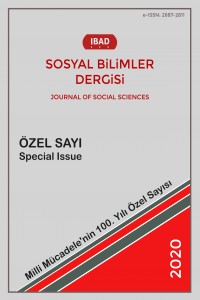Öz
Rus yazar ve bilim insanı Isaac Asimov tarafından 1950'de yazılan I, Robot, gelecekte, 2040'lı yıllarda, insanlar ve makineler arasındaki ilişkiler üzerinden bir arada örülmüş dokuz hikayeden oluşan bir koleksiyondur. Gazeteci olan kitabın anlatıcısı hikayeleri aktarırken, robopsikolog olan Dr. Susan Calvin, yeni teknoloji çağının başlangıcından beri U.S. Robots and Mechanical Men adlı şirkette karşılaştığı “robotik” olayları ona anlatmaktadır. Dr. Susan Calvin, şirketin iç sistemini tasvir ederek robotiklerin doğası ve yasaları, zaman zaman yasaların nasıl ihlal edildiği veya tersine çevrildiği ve teknofobi nedeniyle insanlar tarafından robotlara karşı nasıl ayrımcılık yapıldığı hakkında bilgi vermektedir. Hikâyelerde yer alan robotların çoğu, temelinde insanları korumak için tasarlanmış olan mükemmel robotik sistemine aykırı bir şekilde özerklik, bilinç ve eylemsellik kazanır. Böylece, bu çalışma, Asimov’un kitabındaki özellikle altı hikayede görülen teknofobi ve eylemselliğin robotlar tarafından somutlaştırılması meselesini insan-sonrası (posthuman) kuramı yoluyla ve yazarın biyografisine değinerek incelemeyi amaçlamaktadır. Son olarak çalışma, posthümanizm perspektifinden kitabın bir uyarlaması olarak I, Robot filmini ele alacaktır.
Anahtar Kelimeler
Kaynakça
- Asimov, I. (2001). I, Robot. 15.12.2013. http://ekladata.com/-Byix64G_NtE0xI4A6PA1--o1Hc/Asimov-Isaac-I-Robot.pdf
- Bartlett, L. and Byers, T. (2003). “Back to the Future: The Humanist Matrix”. Cultural Critique. No: 53, Posthumanism Issue: 28-26.
- Braidotti, R. (2013). The Posthuman. Cambridge: Polity.
- Clarke, R. (1999). “Asimov’s Laws of Robotics: Implications for Information Technology Part 2” Computer, Vol. 27: 57-66.
- Dinello, D. (2005). Technophobia!: Science Fiction Visions of Posthuman Technology. Austin: University of Texas Press.
- Ferrando, F. (2019). “The Posthuman Divine: When Robots Can Be Enlightened” Sophia 58: 645-651.
- Haraway, D. (2008). When Species Meet. Minneapolis: University of Minnesota Press.
- Hayles, K. N. (2006). “Unfinished Work: From Cyborg to Cognisphere”. Theory, Culture & Society, Vol. 23 Issue 7-8: 159-166.
- Holmes, M. and Homol, L. (2009). “Isaac Asimov” The Pennsylvania State University. 21.12.2013. https://pabook.libraries.psu.edu/literary-cultural-heritage-map-pa/bios/Asimov__Isaac
- Keller, J. (2006). “Asimov’s Writing Involving Robots” 21.12.2013. http://academic.depauw.edu/aevans_web/HONR101-02/WebPages/Spring2006/Keller(Juliana)/writing.htm
- Murphy, R. and Woods, D. (2009). “Beyond Asimov: The Three Laws of Responsible Robotics” IEEE Intelligent Systems, Vol. 24 No. 4: 14-20.
- Palmer, L. (2011). “Black Man/White Machine: Will Smith Crosses Over”. The Velvet Light Trap. Number 67: 28-40.
- Svilpis, J. (1983). “Authority, Autonomy and Adventure in Juvenile Science Fiction”. Children’s Literary Association Quarterly, Vol. 8 No 3: 22-26.
- Szollosy, M. (2017). “Freud, Frankenstein and our fear of robots: projection in our cultural perception of technology” AI & Soc, 32: 433–439.
Öz
Written by Russian author and scientist Isaac Asimov in 1950, I, Robot is a collection of nine stories interwoven together through the relationships between humans and machines in the future, around the 2040s. The narrator of the book, a journalist, recounts the stories while a robopsychologist, Dr Susan Calvin, reports him the “robotic” incidents that she has encountered in the company, U.S. Robots and Mechanical Men, since the beginning of the new technology age. Depicting the inner system of the company, Dr Susan Calvin provides information about the nature and the laws of the robotics, and how the laws have been violated or reversed at times and how the robots are discriminated by humans because of technophobia. Most of the robots in the stories acquire autonomy, consciousness and agency disturbing the well-set system of robotics which is designed to protect human beings in the first place. Hence, this study aims to analyse technophobia and the matter of embodying agency by robots in especially six stories in Asimov’s book with reference to the posthuman theory and the biography of the author. Finally, it will dissect the film I, Robot as an adaptation of the book from the perspective of posthumanism.
Anahtar Kelimeler
Kaynakça
- Asimov, I. (2001). I, Robot. 15.12.2013. http://ekladata.com/-Byix64G_NtE0xI4A6PA1--o1Hc/Asimov-Isaac-I-Robot.pdf
- Bartlett, L. and Byers, T. (2003). “Back to the Future: The Humanist Matrix”. Cultural Critique. No: 53, Posthumanism Issue: 28-26.
- Braidotti, R. (2013). The Posthuman. Cambridge: Polity.
- Clarke, R. (1999). “Asimov’s Laws of Robotics: Implications for Information Technology Part 2” Computer, Vol. 27: 57-66.
- Dinello, D. (2005). Technophobia!: Science Fiction Visions of Posthuman Technology. Austin: University of Texas Press.
- Ferrando, F. (2019). “The Posthuman Divine: When Robots Can Be Enlightened” Sophia 58: 645-651.
- Haraway, D. (2008). When Species Meet. Minneapolis: University of Minnesota Press.
- Hayles, K. N. (2006). “Unfinished Work: From Cyborg to Cognisphere”. Theory, Culture & Society, Vol. 23 Issue 7-8: 159-166.
- Holmes, M. and Homol, L. (2009). “Isaac Asimov” The Pennsylvania State University. 21.12.2013. https://pabook.libraries.psu.edu/literary-cultural-heritage-map-pa/bios/Asimov__Isaac
- Keller, J. (2006). “Asimov’s Writing Involving Robots” 21.12.2013. http://academic.depauw.edu/aevans_web/HONR101-02/WebPages/Spring2006/Keller(Juliana)/writing.htm
- Murphy, R. and Woods, D. (2009). “Beyond Asimov: The Three Laws of Responsible Robotics” IEEE Intelligent Systems, Vol. 24 No. 4: 14-20.
- Palmer, L. (2011). “Black Man/White Machine: Will Smith Crosses Over”. The Velvet Light Trap. Number 67: 28-40.
- Svilpis, J. (1983). “Authority, Autonomy and Adventure in Juvenile Science Fiction”. Children’s Literary Association Quarterly, Vol. 8 No 3: 22-26.
- Szollosy, M. (2017). “Freud, Frankenstein and our fear of robots: projection in our cultural perception of technology” AI & Soc, 32: 433–439.
Ayrıntılar
| Birincil Dil | İngilizce |
|---|---|
| Bölüm | Araştırma Makalesi |
| Yazarlar | |
| Yayımlanma Tarihi | 18 Aralık 2020 |
| Kabul Tarihi | 14 Ekim 2020 |
| Yayımlandığı Sayı | Yıl 2020 Milli Mücadele'nin 100. Yılı Özel Sayısı |
Etik İlkeler ve Yayın Politikası |
This journal is subscribes to the principles of the Committee on Publication Ethics. |
IBAD Sosyal Bilimler Dergisi I (online) ISSN 2687-2811

